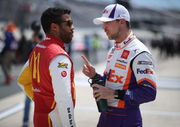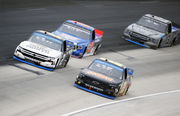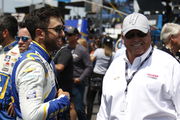
USA Today via Reuters
Jul 23, 2023; Long Pond, Pennsylvania, USA; NASCAR Cup Series driver Kyle Larson (5) races to the inside of driver William Byron (24) during the HighPoint.com 400 at Pocono Raceway. Mandatory Credit: Matthew O’Haren-USA TODAY Sports

USA Today via Reuters
Jul 23, 2023; Long Pond, Pennsylvania, USA; NASCAR Cup Series driver Kyle Larson (5) races to the inside of driver William Byron (24) during the HighPoint.com 400 at Pocono Raceway. Mandatory Credit: Matthew O’Haren-USA TODAY Sports
When you think of big names like Brian Vickers, Kasey Kahne, and Bill Elliott, you’d bet your bottom dollar that the team they drove for was destined for greatness. The Red Bull Racing team, a jack of all trades, made a splash in the world of Formula 1, MotoGP, and Supercars. But when it came to NASCAR, it’s like they hit a wall.
Recently, this blast from the past was brought back into the limelight by Matt Weaver of Sportsnaut on X. Weaver sparked a lively debate about the team’s potential back in the day. Weaver’s take? They were ahead of their time—a whole decade too early. It just goes to show that timing matters.
ADVERTISEMENT
Article continues below this ad
Why did Red Bull Racing, steered by Roger Penske, stumble in NASCAR?
Back in 2011, when the team decided to bow out of NASCAR, it left everyone gobsmacked. The fact that they were on the verge of bringing Clint Bowyer on board to fill Kasey Kahne’s shoes came as a shocker for everyone. Nobody saw it coming, not even the folks in the garage. Red Bull, under the wing of Mateschitz, dove into the NASCAR scene with Toyota in 2007, but, as fate would have it, they fell short.
Their lack of a deep dive into the nitty-gritty of NASCAR was apparent. They roped in A.J. Allmendinger, a rising star in open-wheel racing, but he was green around the edges for the Cup scene. Although their foray into Formula 1 was a hit, it took them a good five seasons to clinch a win. Word on the street is that Red Bull splurged close to a whopping $1 billion in F1. In contrast, their NASCAR adventure cost them a fraction of that, likely under $200 million over five years.
In the end, for Mateschitz and Red Bull, the juice wasn’t worth the squeeze. Matt Weaver, though, thinks they had the makings of a success story. He mused that they were just a decade too early for NASCAR’s evolving landscape. “I sometimes think about the business model of Red Bull Racing Team (NASCAR) and how they were just a decade too early. Imagine a Guenther Steiner-led Cup team in the current climate and the genuine pursuit of a younger demo. Red Bull in the same garage as Trackhouse and 23XI,” he reflected.
I sometimes think about the business model of Red Bull Racing Team (NASCAR) and how they were just a decade too early.
Imagine a Guenther Steiner led Cup team in the current climate and the genuine pursuit of a younger demo.
Red Bull in the same garage as Trackhouse and 23XI.
— Matt Weaver (@MattWeaverRA) January 3, 2024
Brett Griffin, weighing in, wondered if it was a case of not getting enough bang for their buck or just being too early for the party. Matt Weaver agreed that it’s a mix of both, not to mention their knack for throwing legendary parties.
Watch This Story: Aric Almirola and Ricky Stenhouse Jr. Clash on the NASCAR Track
Another angle is the high cost of NASCAR. Red Bull tried to go solo, which eventually backfired. While they didn’t have to scramble for sponsors every season, footing the bill for a car, its damages, and the whole shebang can bleed a company dry if they’re flying solo. But maybe, just maybe, that’s not the whole story behind Red Bull’s NASCAR exit.
Trending
A further dissection of Red Bull’s failed attempt in America’s Biggest Motorsport
Brian Vickers was their only mainstay, but he wasn’t there from the get-go. They played musical chairs with their drivers, parting ways with A.J. Allmendinger too soon and bringing in Scott Speed and Mike Skinner. Instead of nurturing the young duo of Vickers (23 in 2007) and Allmendinger (25 in 2007), they split them up prematurely. By the time Kasey Kahne joined the team for a short stint, the damage was done.
ADVERTISEMENT
Article continues below this ad
Other than that, with their Formula 1 operation, where they’re wizards at building car bodies and tuning engines they get from Renault, In NASCAR, it seemed like they just took whatever TRD/Triad handed them and made a run for it. This lack of innovation could have been a big stumbling block.
In F1, where they juggled two teams, they were a force to be reckoned with. But in NASCAR, they barely scratched the surface in research and development. They had some decent pit crews now and then but struggled to retain top-notch staff.
Read More: Defying Unwritten Rules in NASCAR: Top 5 Black Moments
ADVERTISEMENT
Article continues below this ad
Their driver development program was pretty lackluster too. Sure, there were a few promising talents, but they didn’t invest much in grooming them in the lower series. Instead, they often sent their up-and-comers to any team with a Toyota badge and an empty seat.
Now, just imagine if they had poured the same time and resources into their NASCAR efforts as they do in Formula 1. What if they had snagged drivers like Chase Elliott, Denny Hamlin, or Martin Truex Jr? It’s a classic case of “what if” in a sport where deep pockets and a hunger to win are becoming rarer by the day. Red Bull had both, but somehow, it just didn’t click in NASCAR.
ADVERTISEMENT
ADVERTISEMENT
ADVERTISEMENT
ADVERTISEMENT






